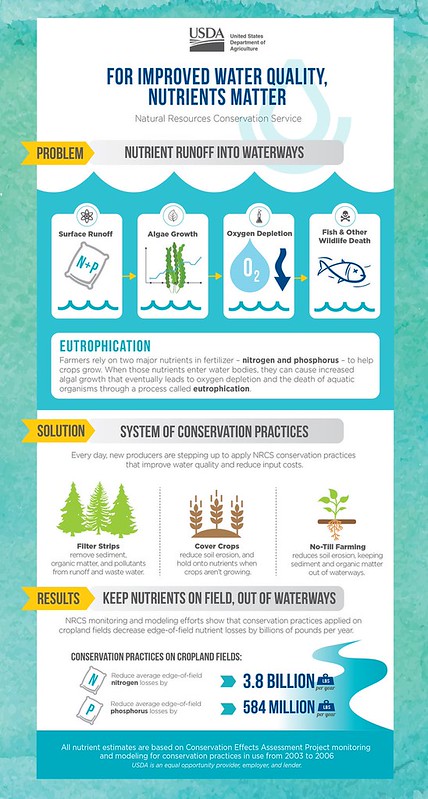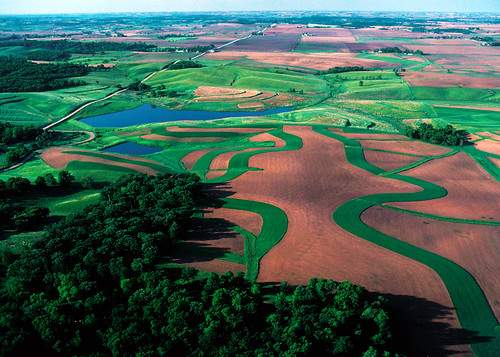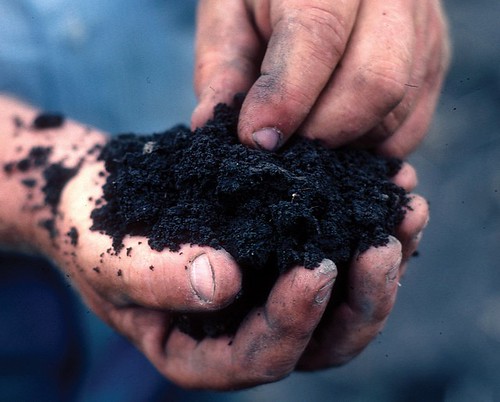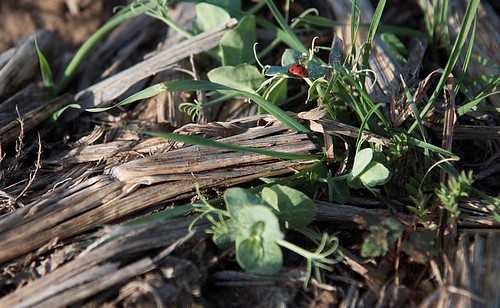
Clean water is a priority for all of us. When farmers manage nutrients, they are also helping to minimize the runoff of nutrients into local streams and rivers.
Bottom Line: For Improved Water Quality, Nutrients Matter.

Farmers rely on two major nutrients in fertilizer — nitrogen and phosphorus — to help crops grow. When excess fertilizer leaves the field and enters local waterways in surface water runoff, those nutrients cause algae in the water to bloom much faster than it would under normal conditions. The algae eventually breaks down, and the bacteria involved in decomposition deplete oxygen in the water to unhealthily low levels. Ultimately, fish and other aquatic organisms often die as a result of this oxygen depletion. This process is called eutrophication.
Voluntary Conservation is Part of the Solution.
Working with the Natural Resources Conservation Service (NRCS), farmers apply a system of conservation strategies to keep valuable fertilizer on their land and out of nearby waterways. Filter strips move row crop operations away from streams and function as collection centers for nutrient runoff. Cover crops reduce soil erosion and hold nutrients in place. No-till practices also reduce soil erosion and improve field-level water infiltration capacity.

According to David Brandt — a corn, wheat, and soybeans producer in Carroll, Ohio — those last two practices make all the difference.
“Innovative farmers are working to improve air and water quality across the country,” says Brandt, “and what we’re doing with cover cropping and no-till is really working.”
Brandt has been using no-till practices since 1971 and cover cropping since 1978. “If every farmer in the United States cover cropped, we’d see even more nutrients held in-field. That really matters when we’re thinking about water quality. When a raindrop falls, we need to be able to control it.”
Brandt’s message is clear: Conservation practices are good for his land, the environment around him, and his bottom line. “We need to educate as many people as we can, farmers and non-farmers alike. The work we do here really makes a difference, and that’s something to be proud of.”
Our Numbers Tell the Story.
Approximately 300 million acres of land across the United States are used for cultivated crop production. That’s almost three areas the size of California, managed by farmers and landowners with production goals similar to David Brandt’s.
Nationwide, conservation practices on croplands play a critical role in improved water quality. Modeling efforts show that national cropland conservation practices implemented from 2003 to 2006 decrease edge-of-field nitrogen losses by 3.8 billion pounds per year and edge-of-field phosphorus losses by 584 million pounds per year relative to if no conservation practices were in use.
If you were to put those nutrients on a train, you’d have enough nitrogen and phosphorus to fill nearly 21,000 train cars stretching 237 miles – a distance further than Washington, DC to New York City - per year.1
In terms of fertilizer, nitrogen savings alone account for about 927 million dollars’ worth of anhydrous ammonia held in-field annually.2
Mr. Brandt is unsurprised by these findings, citing less than 100 pounds of soil lost per acre from his fields each year. “We need to get this information out there,” he says. “We need to show the numbers to tell the story.”

We Expect a Future of Improvements.
Every day, new producers are stepping up to work hand-in-hand with NRCS to implement systems that improve water quality and reduce input costs by trapping and controlling in-field nutrients.
Many producers have joined their friends and neighbors in landscape-scale efforts to minimize agricultural impacts and improve water quality throughout entire watersheds. By adopting a systems approach to conservation across the landscape, these targeted efforts have resulted in an ever-growing list of streams restored in working agricultural land.
We already have several success stories.
In the Chesapeake Bay region, conservation practices used by farmers in 2011 reduce the total nitrogen and phosphorus delivered from crop fields to rivers and streams by 44 percent and 75 percent, respectively. Cropland conservation efforts in place across the Western Lake Erie basin in 2012 reduce the amount of phosphorus and nitrogen entering Lake Erie by 41 and 17 percent relative to conditions without these efforts.
Every pound of nutrients held in-field is a pound that cannot enter local waterways. It is also a pound that producers will not need to replace.
To view the Conservation Effects Assessment Project (CEAP) studies and results in a multimedia format, visit the CEAP Story Maps. Visit the NRCS website to learn more about voluntary conservation programs for your working lands.
1 Assumes that the freight capacity of one train car is 210,000 pounds and the length of one train car is 60 feet.
2 Assumes the use of anhydrous ammonia fertilizer that is 82 percent nitrogen and priced at $400 per ton.

